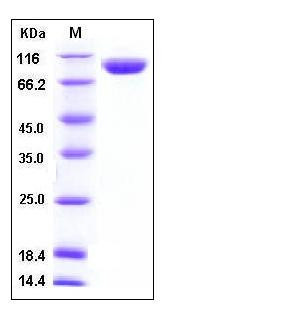Mouse PIGR Protein (His Tag)
Pigr
- 100ug (NPP2773) Please inquiry
| Catalog Number | P50119-M08H |
|---|---|
| Organism Species | Mouse |
| Host | Human Cells |
| Synonyms | Pigr |
| Molecular Weight | The secreted recombinant mouse PIGR consists of 638 amino acids and has a calculated molecular mass of 70.8 kDa. As a result of glycosylation, the recombinant protein migrates as an approximately 90-100 kDa protein in SDS-PAGE under reducing conditions. |
| predicted N | Lys 19 |
| SDS-PAGE |  |
| Purity | > 97 % as determined by SDS-PAGE |
| Protein Construction | A DNA sequence encoding the extracellular domain (Met 1-Lys 645) of mouse PIGR (NP_035212.2) precursor was expressed with a C-terminal polyhistidine tag. |
| Bio-activity | Measured by its binding ability in a functional ELISA . Immobilized recombinant mouse PIGR at 5 μg/ml (100 μl/well) can bind mouse IgM with a linear range of 0.156-10 μg/ml . |
| Research Area | |
| Formulation | Lyophilized from sterile PBS, pH 7.4 1. Normally 5 % - 8 % trehalose, mannitol and 0.01% Tween80 are added as protectants before lyophilization. Specific concentrations are included in the hardcopy of COA. |
| Background | Polymeric immunoglobulin receptor, also known as PIGR, is a member of the immunoglobulin superfamily and a Fc receptor. The ectodomain of this receptor consists of five units with homology to the variable units of immunoglobulins and a transmembrane region, which also has some homology to certain immunoglobulin variable regions. PIGR is expressed on several glandular epithelia including those of liver and breast. The deduced amino-acid sequence has a length of 764 residues and shows an overall similarity of 56% and 64% with the rabbit and rat counterpart. PIGR mediates transcellular transport of polymeric immunoglobulin molecules, and thus facilitates the secretion of IgA and IgM. During this process, a cleavage occurs that separates the extracellular (known as the secretory component) from the transmembrane segment of PIGR. |
| Reference |
